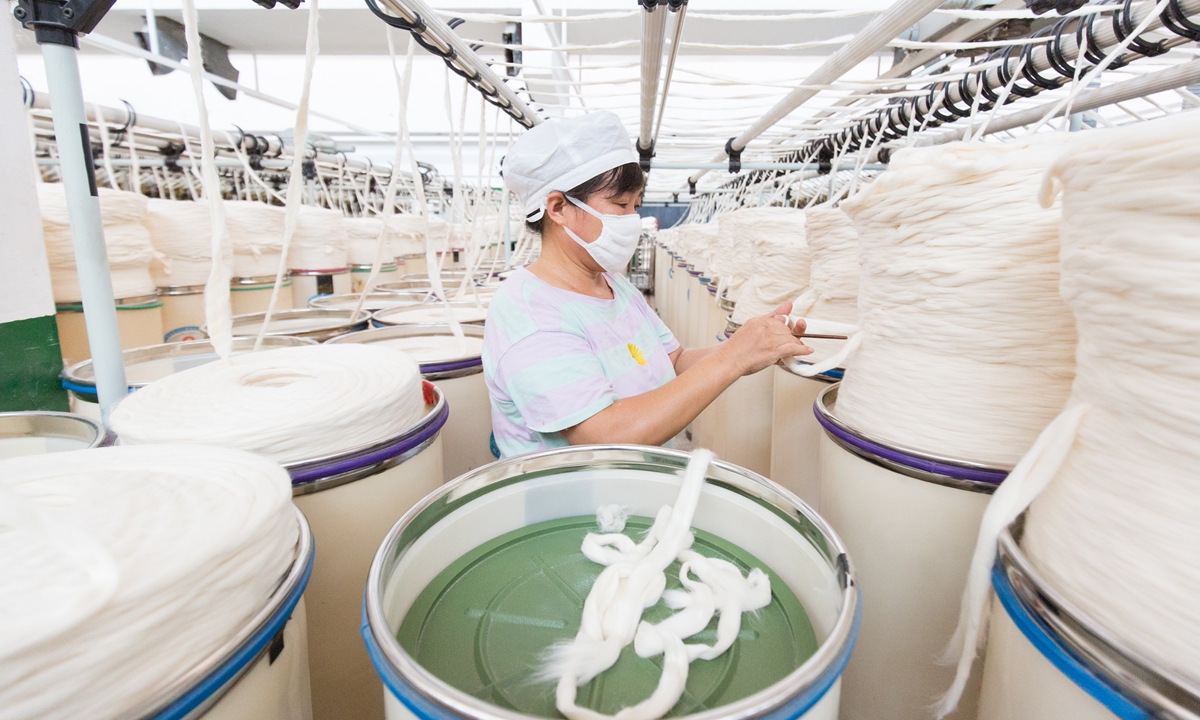Normal market move for textile orders to return from India to China: MOFCOM
By Zhang Hongpei and Yin Yeping Source: Global Times Published: 2020/10/14 22:08:40
Customers transfer work from India as pandemic continues

A cotton spinner is seen at work in a textile factory in East China's Jiangsu Province on October 10. Photo: cnsphoto
With the COVID-19 pandemic effectively under control in China, more textile orders originally placed by multinationals in India have shifted to China in recent months, which is a normal market reaction, a senior Chinese official said on Wednesday.
"Multinationals adjust production on a global scale, and international buyers select suppliers based on production capacity, which are all normal market decisions," said Li Xingqian, director of the Foreign Trade Department of China's Ministry of Commerce (MOFCOM).
"There are also some orders being transferred from China to other countries or markets for production," Li said.
International garment producers are shifting orders placed with Indian textile vendors back to Chinese ones, given the former's insufficient measures to control the pandemic, which has meant many large export-oriented textile companies in India cannot guarantee normal deliveries.
India's coronavirus tally has surged to 7,239,300 confirmed cases after a fresh spike of 63,509 infections in the last 24 hours, data from India's Ministry of Health and Welfare showed on Wednesday.
A veteran industry observer surnamed Mao, based in East China's Zhejiang Province, told the Global Times on Wednesday that many orders have been sent back to Zhejiang's Shaoxing, where textiles are the core industry.
"It's a natural that European and American retailers make the change in order to ensure that their supplies will not be affected during the Thanksgiving and Christmas sales seasons," Mao said.
He said the order transfers will continue through the end of this year.
A sales manager surnamed Wu with a textile factory based in South China's Guangdong Province told the Global Times on Wednesday that more orders are coming from various countries including India, which has taken up to 50 percent of the company's production, up from about 30 percent before the pandemic.
"We receive phone calls and emails from India with inquiries almost every day and some companies have already placed orders," said Wu, noting that many clients from India cannot meet the demand from Western garment firms.
Wu said that the company treats all clients fairly, but it prefers not to take orders from clients in India, who often pay at the last minute while many others pay in advance.
Wu's factory is also taking orders from Southeast Asian countries, where demand has been rising amid the pandemic.
As the world's largest cotton producer and second-largest silk producer, India has been heavily reliant on the textile industry, which accounts for about 15 percent of the country's export revenues, data showed.
Apart from India, there are also orders flowing back from other countries.
A source at a Chinese company based in Bangladesh, who asked to remain anonymous, told the Global Times on Wednesday that when the epidemic was very severe in the country earlier this year, garment factories were closed.
"Since the raw materials are mainly imported from China, shipping and customs clearance were disrupted due to the epidemic. Many orders in Bangladesh have also been transferred to China," said the source.
China is home to 60 percent of the world's clothing materials, and 20 percent of the international trade of semi-finished goods such as spinning thread, cloth and zippers is related to China, according to reports.
Some labor-intensive sectors such as clothes processing shifted from the Chinese mainland to emerging markets like India, Vietnam and Bangladesh in recent years as multinationals could get cheaper labor and raw materials.
"There is competition between China and those markets in the textile industry for international orders, but China is moving toward the high end of the textile sector, narrowing the gap with developed countries, and that should be what we aim for," Mao said.
Despite the heavy blow to China's textile industry during the pandemic, the industry has been recovering since mid-year.
Industry data showed that from January to August, textile and apparel exports amounted to $187.41 billion, a year-on-year increase of 5.6 percent. That growth rate was 1.3 percentage points higher than the January-July period.
In August, clothing exports stood at $16.21 billion, up 3.2 percent year-on-year, the first expansion this year.
Newspaper headline: Textile orders return to China
Posted in: INDUSTRIES